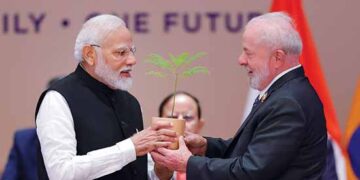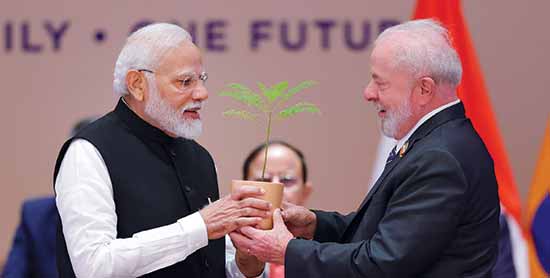Team Blitz India
A MOMENTOUS congregation of the world’s biggest 20 countries in India had to have a long-lasting impact. After the departure of the guests and curtains on the G20 Summit in New Delhi, there had to be something to remember the occasion by. Getting the guests to plant a sapling was an obvious choice; but Prime Minister Narendra Modi took it to the next level by getting the saplings flown from different parts of the world.
Several saplings of national trees of the 20 countries being represented by their heads of state at the G20 Summit reached New Delhi much before the guests arrived. The task of finding the right species of trees was entrusted to the Ministry of External Affairs, which, in turn, took the help of the Ministry of Agriculture.
Feasibility of survival
According to media reports, Indian embassies in respective countries were mobilised to scout for the saplings, experts were engaged to examine the feasibility of the survival of the plants in Indian conditions and an agency given the responsibility of handling and caring for the precious greens.
The ICAR-National Bureau of Plant Genetic Resources at Pusa, New Delhi, imported these saplings over two months and the plants were kept at a post-entry quarantine facility.
At least 17 countries, including China, Japan, Argentina, and the United Arab Emirates, exported saplings to India. The plants included Camphor Laurel (Cinnamomum camphora) from China and Japan, Cockspur Coral (Erythrina crysta-galli) from Argentina, and Ghaf from the United Arab Emirates.
Non-G20 members
About 12 small Winterlinde trees were brought from Germany, seven olive plants from Turkey, five Real Yellowwood plants from South Africa, and six date palm plants from Saudi Arabia.
In addition, there were some countries that were not part of the G20, but they brought saplings of various trees. These countries included Oman, Mauritius, Bangladesh, Nigeria, Egypt, and Spain. They brought trees like the Ghaf tree, Frankincense, Frangipani, Mango tree and African Mahogany from their respective regions.
SAPLINGS PLANTED
| Country | Species |
|---|---|
| South Korea | Silver Tree |
| France | Sycamore/chinar |
| Russia | Chir pine |
| US | Crepe myrtle |
| UK | Weeping willow |
| Canada | Arjun |
| Indonesia | Teak |
| Saudi Arabia | Date Palm |
| Italy | Olive Tree |
| South Africa | Real Yellowwood |
| Turkey | Olive Tree |
| Germany | Winterlinde |
| Argentina | Cockspur Coral Tree |
| Germany | Winterlinde |
| Japan | Camphor Laurel |
| Australia | Golden Wattle |
| China | Camphor |
| Brazil | Fern |

Cinnamomum Camphora
CHINA
An evergreen tree, commonly known as the camphor tree, this plant is native to China, south of River Yangtze, and has been introduced in many other countries. The camphor tree grows up to 20-30 meters and its leaves are glossy with a waxy appearance. The plant has several medicinal qualities.

Cockspur Coral
ARGENTINA
Cockspur Coral, or Erythrina crista-galli, is a flowering tree in the family Fabaceae, native to Argentina, Uruguay, southern Brazil and Paraguay. It is planted as a street or garden tree in other countries. It is the national tree of Argentina and its flower the nation’s national flower

Silver Fir Tree
SOUTH KOREA
Korean Fir is a very popular ornamental plant in parks and gardens in temperate climates, grown for its foliage but also for the abundant cone production even on young trees. It is a species of fir, native to the mountains of South Korea

Date Palm
SAUDI ARABIA
Phoenix Dactylifera, commonly known as date palm, is a flowering plant species in palm family and it is cultivated for its sweet fruit called dates. The species is widely cultivated across northern Africa, the Middle East and South Asia. The date palm tree can grow up to 100 feet tall and live up to 100 years.

Olive Tree
ITALY
The Olea Europaea, meaning European olive, is a species of small tree or shrub found traditionally in the Mediterranean basin. The fruit of this plant is the source of olive oil and is the core ingredient in Mediterranean cooking.

Real Yellowwood
SOUTH AFRICA
This is a large evergreen tree, up to 35 m high and 3 m of trunk diameter. Real Yellowwood is the national tree of South Africa and is protected there. It is a slowgrowing tree but lives for very long. Its wood is hard and is used for furniture and paneling etc.
Team Blitz India
A MOMENTOUS congregation of the world’s biggest 20 countries in India had to have a long-lasting impact. After the departure of the guests and curtains on the G20 Summit in New Delhi, there had to be something to remember the occasion by. Getting the guests to plant a sapling was an obvious choice; but Prime Minister Narendra Modi took it to the next level by getting the saplings flown from different parts of the world.
Several saplings of national trees of the 20 countries being represented by their heads of state at the G20 Summit reached New Delhi much before the guests arrived. The task of finding the right species of trees was entrusted to the Ministry of External Affairs, which, in turn, took the help of the Ministry of Agriculture.
Feasibility of survival
According to media reports, Indian embassies in respective countries were mobilised to scout for the saplings, experts were engaged to examine the feasibility of the survival of the plants in Indian conditions and an agency given the responsibility of handling and caring for the precious greens.
The ICAR-National Bureau of Plant Genetic Resources at Pusa, New Delhi, imported these saplings over two months and the plants were kept at a post-entry quarantine facility.
At least 17 countries, including China, Japan, Argentina, and the United Arab Emirates, exported saplings to India. The plants included Camphor Laurel (Cinnamomum camphora) from China and Japan, Cockspur Coral (Erythrina crysta-galli) from Argentina, and Ghaf from the United Arab Emirates.
Non-G20 members
About 12 small Winterlinde trees were brought from Germany, seven olive plants from Turkey, five Real Yellowwood plants from South Africa, and six date palm plants from Saudi Arabia.
In addition, there were some countries that were not part of the G20, but they brought saplings of various trees. These countries included Oman, Mauritius, Bangladesh, Nigeria, Egypt, and Spain. They brought trees like the Ghaf tree, Frankincense, Frangipani, Mango tree and African Mahogany from their respective regions.
SAPLINGS PLANTED
| Country | Species |
|---|---|
| South Korea | Silver Tree |
| France | Sycamore/chinar |
| Russia | Chir pine |
| US | Crepe myrtle |
| UK | Weeping willow |
| Canada | Arjun |
| Indonesia | Teak |
| Saudi Arabia | Date Palm |
| Italy | Olive Tree |
| South Africa | Real Yellowwood |
| Turkey | Olive Tree |
| Germany | Winterlinde |
| Argentina | Cockspur Coral Tree |
| Germany | Winterlinde |
| Japan | Camphor Laurel |
| Australia | Golden Wattle |
| China | Camphor |
| Brazil | Fern |

Cinnamomum Camphora
CHINA
An evergreen tree, commonly known as the camphor tree, this plant is native to China, south of River Yangtze, and has been introduced in many other countries. The camphor tree grows up to 20-30 meters and its leaves are glossy with a waxy appearance. The plant has several medicinal qualities.

Cockspur Coral
ARGENTINA
Cockspur Coral, or Erythrina crista-galli, is a flowering tree in the family Fabaceae, native to Argentina, Uruguay, southern Brazil and Paraguay. It is planted as a street or garden tree in other countries. It is the national tree of Argentina and its flower the nation’s national flower

Silver Fir Tree
SOUTH KOREA
Korean Fir is a very popular ornamental plant in parks and gardens in temperate climates, grown for its foliage but also for the abundant cone production even on young trees. It is a species of fir, native to the mountains of South Korea

Date Palm
SAUDI ARABIA
Phoenix Dactylifera, commonly known as date palm, is a flowering plant species in palm family and it is cultivated for its sweet fruit called dates. The species is widely cultivated across northern Africa, the Middle East and South Asia. The date palm tree can grow up to 100 feet tall and live up to 100 years.

Olive Tree
ITALY
The Olea Europaea, meaning European olive, is a species of small tree or shrub found traditionally in the Mediterranean basin. The fruit of this plant is the source of olive oil and is the core ingredient in Mediterranean cooking.

Real Yellowwood
SOUTH AFRICA
This is a large evergreen tree, up to 35 m high and 3 m of trunk diameter. Real Yellowwood is the national tree of South Africa and is protected there. It is a slowgrowing tree but lives for very long. Its wood is hard and is used for furniture and paneling etc.














 G20 podium
G20 podium

